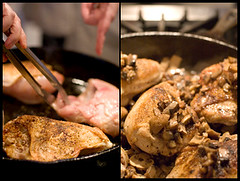America’s Second Harvest (A2H), the nation’s largest network of emergency food providers, conducted a study in 2005 for the nation’s food bank network. The study was based on completed in-person interviews with 52,878 clients served by the A2H National Network, as well as on completed questionnaires from 31,342 A2H agencies. The study summarized below focuses mainly on emergency food providers and their clients who are supplied with food and other services by members of the A2H Network. Here, emergency food providers are defined to include food pantries, soup kitchens, and emergency shelters serving short-term residents.
Below I've selected some of the major results from the study. I think you will find many of these results very interesting.
• The A2H system served an estimated 24 to 27 million unduplicated people annually. This includes 22 to 25 million pantry users, 1.2 to 1.4 million kitchen users, and 0.8 million shelter users (Table 4.2.1).• Approximately 4.5 million different people receive emergency food assistance from the A2H system in any given week.
• 36.4% of the members of households served by the A2H National Network are children under 18 years old.
• 8% of the members of households are children age 0 to 5 years.
• 10% of the members of households are elderly.
• About 40% of clients are non-Hispanic white; 38% are non-Hispanic black, and the rest are from other racial groups. 17% are Hispanic.
• 36% of households include at least one employed adult.
• 68% have incomes below the official federal poverty level.
• 12% are homeless.
• 42% of clients served by the A2H National Network report having to choose between paying for food and paying for utilities or heating fuel.
• 35% had to choose between paying for food and paying their rent or mortgage.
• 32% had to choose between paying for food and paying for medicine or medical care.
• 35% of client households served by the A2H National Network are receiving Food Stamp Program benefits; however, it is likely that many more are eligible.
• Among households with children ages 0-3 years, 51% participate in the Supplemental Nutrition Program for Women, Infants, and Children (WIC).
• Among households with school-age children, 62% and 51%, respectively, participate in the federal school lunch and school breakfast programs.
• 29% of households served by the A2H National Network report having at least one household member in poor health.
• 92% of adult clients said they were either “very satisfied” or “somewhat satisfied” with the amount of food they received from their A2H provider; 93% were satisfied with the quality of the food they received.
WHAT KINDS OF ORGANIZATIONS OPERATE EMERGENCY FOOD PROGRAMS OF THE A2H NATIONAL NETWORK?• 74% of pantries, 65% of kitchens, and 43% of shelters are run by faith-based agencies affiliated with churches, mosques, synagogues, and other religious organizations.
• At the agency level, 69% of agencies with pantry, kitchen, or shelter and 56% of all agencies including those with other programs are faith-based.
• Private nonprofit organizations with no religious affiliation make up a large share of other types of agencies.
• 65% of pantries, 61% of kitchens, and 52% of shelters of the A2H National Network reported that there had been an increase since 2001 in the number of clients who come to their emergency food program sites.
WHERE DO THESE AGENCIES OBTAIN THEIR FOOD?• Food banks are by far the single most important source of food for the agencies, accounting for 74% of the food distributed by pantries, 49% of the food distributed by kitchens, and 42% of the food distributed by shelters.
• Other important sources of food include religious organizations, government, and direct purchases from wholesalers and retailers.
• 69% of pantries, 49% of kitchens, and 46% of shelters receive food from government commodity programs.
VOLUNTEERS ARE EXTREMELY IMPORTANT IN THE A2H NETWORK• As many as 90% of pantries, 86% of kitchens, and 71% of shelters in the A2H National Network use volunteers.
• Many programs rely entirely on volunteers; 66% of pantry programs and 40% of kitchens have no paid staff at all.
You can see the full results of the study by clickling on this
link.










